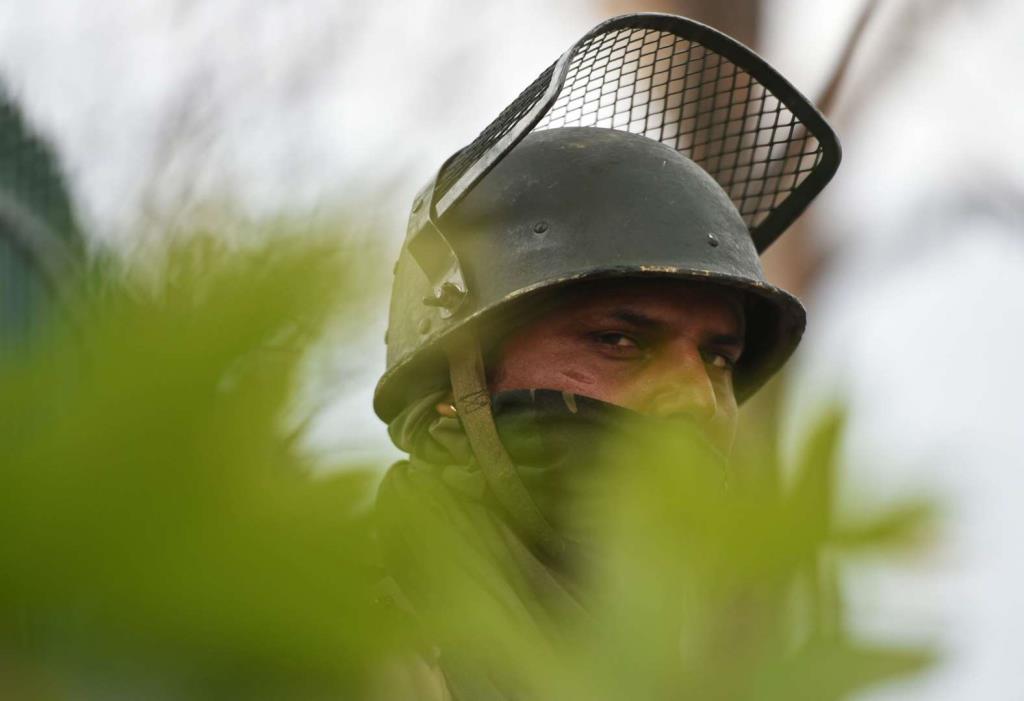June8, 2017
A Kashmiri carpet dealer, who is suspected to have acted as a double agent for Indian as well as Pakistani spy services, is on the radar of the National Investigation Agency (NIA), which is probing the source of Pakistani funding of separatists leaders in the valley.

June8, 2017
A Kashmiri carpet dealer, who is suspected to have acted as a double agent for Indian as well as Pakistani spy services, is on the radar of the National Investigation Agency (NIA), which is probing the source of Pakistani funding of separatists leaders in the valley.

A member of the Indian government forces stands guard in central Srinagar on June 5, 2017. – Tauseef Mustafa/AFP/Getty Images)
The agency, which is investigating whether money from Pakistan was being used to fund violent street protests against the Indian government, is trying to net Nasir Shafi Mir, who is believed to be a Gulf-based businessman. “Mir’s name is figuring in our probe as well,” an NIA official, who spoke on the condition of anonymity given the sensitive nature of the probe, said.
According to former intelligence officials who worked in Kashmir, Mir endeared himself to operatives of the Research and Analysis Wing (R&AW) and the Intelligence Bureau, India’s external and domestic intelligence agencies, by trying to bring terror outfit Hizbul Mujahideen’s chief Mohammad Yusuf Shah alias Syed Salahuddin to the negotiation table in 2000.
“We suspect that he was a conduit for separatist leaders in the valley, Syed Salahuddin as well as for Pakistani spy agency ISI. We knew about his links but he had some usefulness for us also when the Indian government tried to negotiate with Hizbul Mujahideen in the year 2000,” a retired intelligence official, who did not wish to be named, said.
The officer was a key figure in talks with Hizbul while serving in Kashmir at that point in time. As part of negotiations, the masked Hizbul Mujahideen commander met the then Union home secretary Kamal Pandey but talks fell through soon.
The officer added Mir remained useful to Indian intelligence agencies for the next couple of years until it dawned upon the Indian security establishment that he had become more useful for the Pakistanis, who were using him for channeling money to the separatists in the valley. By 2006, Mir’s time was up and he was arrested by the Delhi Police in the national capital in February that year. He was allegedly found in possession of Rs 55 lakh in cash and explosives at the time of arrest.
Mir’s arrest created ripples in the separatist circles in the valley. A senior Kashmiri separatist leader even pleaded on his behalf with the government, said the official. A year after his arrest, Mir was granted bail by a Delhi court on account of his mother’s illness and he has been on the run since then.
It is believed that he has a Pakistani passport now and keeps shuttling between Pakistan and Gulf countries where he has business interests. A former chief of an Indian intelligence agency told the Hindustan Times that Mir was shrewd enough to survive in the intelligence game that was being played in the Kashmir during that time.
He also spoke on the condition of anonymity. The NIA has accused Kashmiri separatists leaders of getting funding from Pakistan-based terror outfit Lashkar-e-Taiba’s ((LeT) patron Hafiz Mohammad Saeed. The NIA raided 26 places across Kashmir, Delhi and Haryana, allegedly recovering letterheads of Hizbul and LeT, laptops, mobile phones, gold jewellery and more than Rs 2.5 crore in cash in what was the first such crackdown on the financing of separatists.
The raids began after the NIA turned a preliminary inquiry into the sources of funding of separatist leaders such as Syed Ali Shah Geelani, Naeem Khan and Farooq Ahmed Dar into a first information report (FIR) or a formal investigation.
The agency’s FIR alleged money received from Pakistan was being used to fund violence in the Kashmir, including an operation to increase stone pelting on security forces and arson that largely targeted schools and government buildings.
Courtesy: HT















































































































